HERE COME THE HARVEY LOW BALLERS 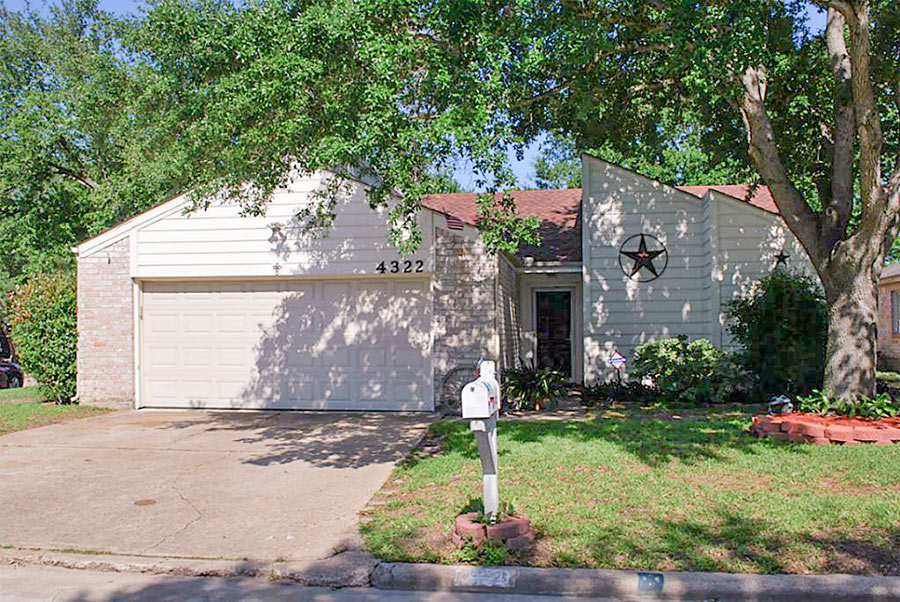 Outsiders moving into town to buy up homes from distressed owners for pennies on the dollar in the wake of local catastrophe is a proud and longstanding Houston tradition: It keeps the city’s reputation for real-estate shenanigans intact, even as oldtimers mellow. It’s how Sir Allen Stanford got his illustrious start! Plus: Investments that must be recouped can help keep zombie neighborhoods that maybe-shouldn’t-have-been-built-there-or-that-way-in-the-first-place alive. But you don’t have to be a wet-carpetbagger to get in on the fun: Reporter Prashant Gopal heads to the Redneck Country Club on Airport Blvd. in Stafford for a well-attended pep talk by local trashed-home recycler Eddie Gant, then follows local real-estate agent Bryan Schild as he drives through neighborhoods looking for deals: “One of Schild’s prospects is Joseph Hernandez, a disabled U.S. Army veteran married to a housekeeper. The couple are living in a hotel and saving money by eating only two meals a day. Schild has made them a painful offer. If they walk away from their two-bedroom house, worth $127,000 before Hurricane Harvey, Schild will pick up the mortgage payments, paying nothing else. Although he says he sympathizes with the Hernandezes’ plight, he thinks the offer is fair because he figures the home is now worth less than its $65,000 mortgage. Hernandez is in a bind. He didn’t buy flood insurance because his house wasn’t in a high-risk area. He can’t afford to rebuild, and he’s been told he’s eligible for only $23,000 in federal assistance. If he turns over the deed, he’s looking at losing the entire $60,000 in equity he had before the flood. ‘It’s blurry, what’s coming,’ he says. ‘We’ll probably have to sell to an investor, and that’s not good. We were forced out.’†[Bloomberg BusinessWeek] Photo of Hernandez’s home in Bear Creek Village, before it flooded: HAR
Outsiders moving into town to buy up homes from distressed owners for pennies on the dollar in the wake of local catastrophe is a proud and longstanding Houston tradition: It keeps the city’s reputation for real-estate shenanigans intact, even as oldtimers mellow. It’s how Sir Allen Stanford got his illustrious start! Plus: Investments that must be recouped can help keep zombie neighborhoods that maybe-shouldn’t-have-been-built-there-or-that-way-in-the-first-place alive. But you don’t have to be a wet-carpetbagger to get in on the fun: Reporter Prashant Gopal heads to the Redneck Country Club on Airport Blvd. in Stafford for a well-attended pep talk by local trashed-home recycler Eddie Gant, then follows local real-estate agent Bryan Schild as he drives through neighborhoods looking for deals: “One of Schild’s prospects is Joseph Hernandez, a disabled U.S. Army veteran married to a housekeeper. The couple are living in a hotel and saving money by eating only two meals a day. Schild has made them a painful offer. If they walk away from their two-bedroom house, worth $127,000 before Hurricane Harvey, Schild will pick up the mortgage payments, paying nothing else. Although he says he sympathizes with the Hernandezes’ plight, he thinks the offer is fair because he figures the home is now worth less than its $65,000 mortgage. Hernandez is in a bind. He didn’t buy flood insurance because his house wasn’t in a high-risk area. He can’t afford to rebuild, and he’s been told he’s eligible for only $23,000 in federal assistance. If he turns over the deed, he’s looking at losing the entire $60,000 in equity he had before the flood. ‘It’s blurry, what’s coming,’ he says. ‘We’ll probably have to sell to an investor, and that’s not good. We were forced out.’†[Bloomberg BusinessWeek] Photo of Hernandez’s home in Bear Creek Village, before it flooded: HAR
Quicklink
EPA: YEAH, BETTER CLEAN OUT THE DIOXIN PITS FROM THE SAN JACINTO RIVER NOW THAT THEY’VE LEAKED A bit later than had been urged by those alarmed by the longterm presence of pits full of toxic waste sealed only with a tarp on top hanging out in the San Jacinto River, the EPA has now approved a plan to remove most of the dioxin stored within them. “As exemplified today, EPA is prioritizing Superfund clean-up by making decisions in a decisive, timely manner,” reads a statement from administrator Scott Pruitt released this afternoon. “The San Jacinto Waste Pits site was added to the National Priority List nearly a decade ago.” What’s the rush? As predicted by EPA studies and many a casual observer, the pits appeared to have leaked extensively after Hurricane Harvey flooding. Under the new $115 million plan, cofferdams will be installed around the pits and almost 212,000 cubic yards of dioxin-contaminated material will be excavated — leaving just enough behind that the agency can, it says, ensure controls that will “prevent access, eliminate off-site migration, and monitor the natural recovery into the future.” [EPA; more info; Houston Chronicle; previously on Swamplot] Video of waste pits after Harvey flooding: Greg Moss
THE RISE AND DECLINE OF AMERICA’S GRANITE COUNTERTOPS OBSESSION Revising the conclusions of his “what made granite countertops so popular” story from 2 years ago, Phil Edwards notes in this new video evidence that the mania for Brazilian, Chinese, and Indian stone surfaces in U.S. kitchens and baths reached its peak about a decade ago: “2006: The granite bubble and housing bubble came at the same time. Just as laminates rode technological and construction booms in the ’50s, granite rode similar waves in the 2000s. Granite was good, but its timing made it overrated — and that might be why we’re starting to correct. The end of that chart [of worked-granite imports to the U.S.] shows a dip in granite. That’s for a lot of reasons, some of which are bigger than interior design trends. But if you watch house hunting shows you’ll see there are other materials catching on.” [Vox; previously on Swamplot] Video: Vox
MIDTOWN SEARS CLOSURE NETS RICE 9 ACRES NEAR THE WHEELER TRANSIT CENTER 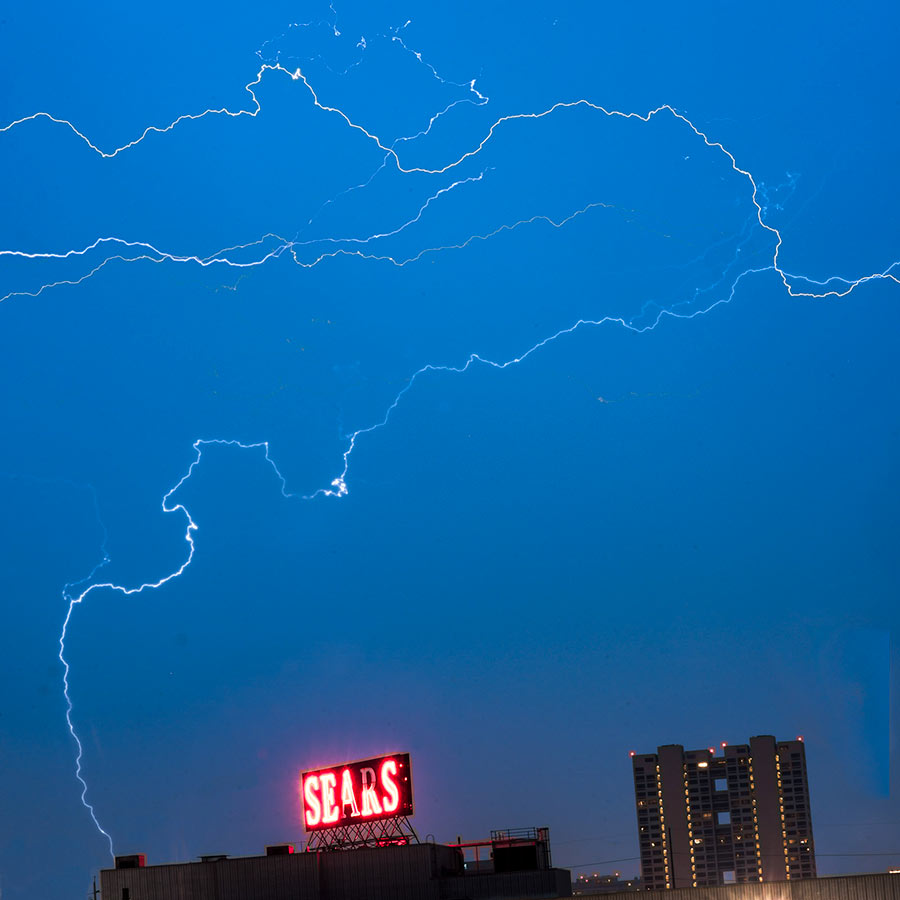 The company that manages Rice University’s $5.3 billion endowment last week bought out the 28 years remaining on a 99-year lease the university had signed with the Sears department store on its Midtown property back in 1945. The Sears at 4201 Main St., which opened in 1939, will close in late January, after a liquidation sale beginning early next month, it was announced today. Rice also bought 3 adjacent acres owned by Sears, giving the university a multi-block 9.4-acre chunk of land near Metro’s Wheeler Transit Center and the Southwest Fwy. it can now decide what to do with. Among the properties on that land: the Sears Auto Center at 4111 Fannin and the Fiesta Mart at 4200 San Jacinto, which has a lease that runs for 2 more years. The Sears’s original art deco façade was covered with metal panels in the 1960s. Rice prez David Leebron says the university will now “initiate a process of thoughtful planning for the future use of this land,” with a yearlong study of options directed by the Rice Management Company. [Houston Chronicle; Click2Houston] Photo: Pete Molick via Swamplot Flickr pool
The company that manages Rice University’s $5.3 billion endowment last week bought out the 28 years remaining on a 99-year lease the university had signed with the Sears department store on its Midtown property back in 1945. The Sears at 4201 Main St., which opened in 1939, will close in late January, after a liquidation sale beginning early next month, it was announced today. Rice also bought 3 adjacent acres owned by Sears, giving the university a multi-block 9.4-acre chunk of land near Metro’s Wheeler Transit Center and the Southwest Fwy. it can now decide what to do with. Among the properties on that land: the Sears Auto Center at 4111 Fannin and the Fiesta Mart at 4200 San Jacinto, which has a lease that runs for 2 more years. The Sears’s original art deco façade was covered with metal panels in the 1960s. Rice prez David Leebron says the university will now “initiate a process of thoughtful planning for the future use of this land,” with a yearlong study of options directed by the Rice Management Company. [Houston Chronicle; Click2Houston] Photo: Pete Molick via Swamplot Flickr pool
COMMENT OF THE DAY: DON’T SAY I DIDN’T WARN YOU ABOUT THE WHOLE MOLD BUSINESS  “So for homeowners you just cut the sheetrock, and rebuild all of the stuff at 3 feet and go down the road? My feeling is that every house that flooded has some trace of E. Coli and mold. Pretty soon you’ll see mold lawyer commercials suing every contractor that worked in these places. Doctors will soon get in on the action too. Hell, back in 2000 when mold lawsuits were born my framer had a magnetic door sign for ‘mold testing and remediation’ in the back seat of his pick-up. Get ready for it again.” [Sporey McGee, commenting on Housing Authority Ready To Demolish More Than a Third of Clayton Homes After Harvey Flooding] Illustration: Lulu
“So for homeowners you just cut the sheetrock, and rebuild all of the stuff at 3 feet and go down the road? My feeling is that every house that flooded has some trace of E. Coli and mold. Pretty soon you’ll see mold lawyer commercials suing every contractor that worked in these places. Doctors will soon get in on the action too. Hell, back in 2000 when mold lawsuits were born my framer had a magnetic door sign for ‘mold testing and remediation’ in the back seat of his pick-up. Get ready for it again.” [Sporey McGee, commenting on Housing Authority Ready To Demolish More Than a Third of Clayton Homes After Harvey Flooding] Illustration: Lulu
THE HEIGHTS HISTORIC DISTRICTS’ NEW HEIGHTS 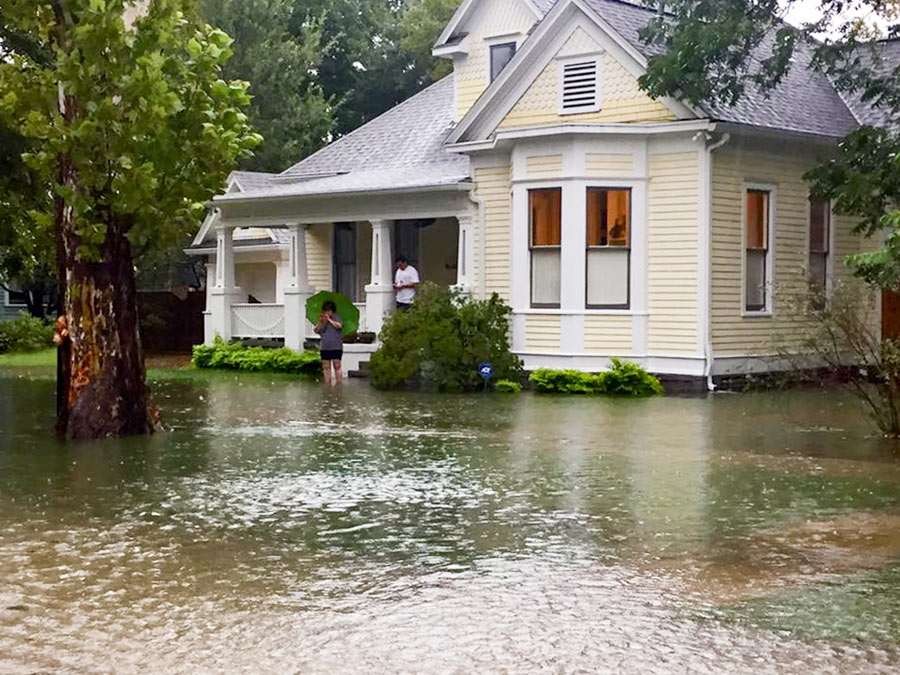 The public comment period for the latest (and presumably final) draft of the design guidelines for the Houston Heights’s 3 historic districts ends today. The latest version of the 223-page document dates from August and covers a range of issues important to the historic districts, including proposed standards for construction and renovation — from roof pitches and “character defining elements” to maximum allowable foundation height (30 inches from natural elevation for new construction and additions) — but does not appear to include any mention of flooding. The guidelines, once adopted, would be used by the Houston Archeological and Historical Commission in its determinations of what proposed building projects would be allowed. [Planning & Development Dept.; previously on Swamplot] Photo of home at 8th St. and Arlington St., in Houston Heights Historic District South, during Harvey: Swamplot inbox
The public comment period for the latest (and presumably final) draft of the design guidelines for the Houston Heights’s 3 historic districts ends today. The latest version of the 223-page document dates from August and covers a range of issues important to the historic districts, including proposed standards for construction and renovation — from roof pitches and “character defining elements” to maximum allowable foundation height (30 inches from natural elevation for new construction and additions) — but does not appear to include any mention of flooding. The guidelines, once adopted, would be used by the Houston Archeological and Historical Commission in its determinations of what proposed building projects would be allowed. [Planning & Development Dept.; previously on Swamplot] Photo of home at 8th St. and Arlington St., in Houston Heights Historic District South, during Harvey: Swamplot inbox
THE PIERCE ELEVATED’S GREAT UNCROSSING 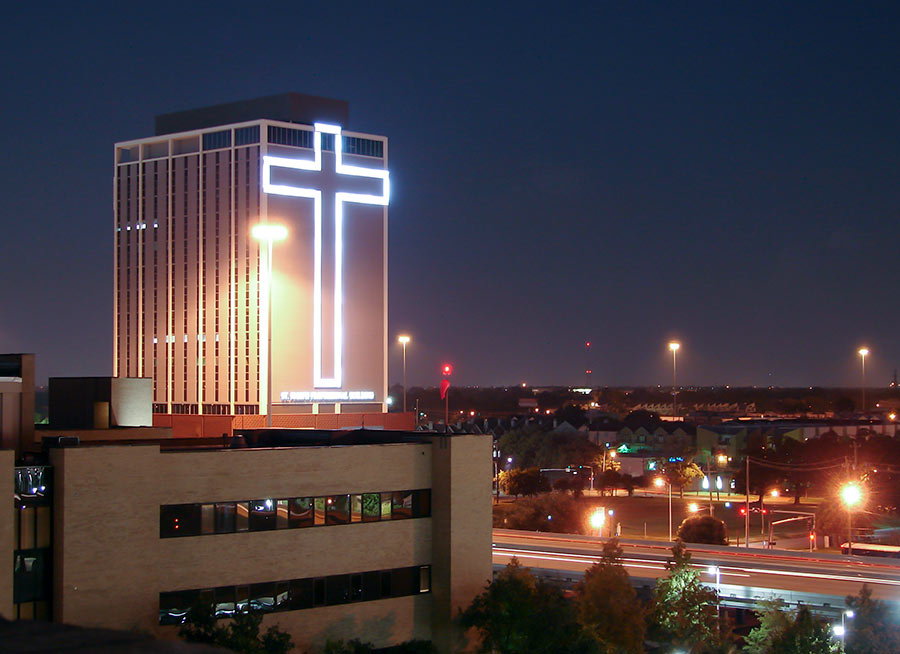 What’s going to replace the giant crosses on the east and west sides of the St. Joseph Professional Building towering over the Pierce Elevated once its new owner takes them down and redoes the exterior? “I want something that’s going to be iconic to Houston,” Boxer Property CEO Andrew Segal tells Katherine Feser. The company has commissioned artists to develop ideas for the 18-story building’s new cross-free exterior look, Segal says: “It may be something that changes at night. It could involve a projector.” Also in the plans for the 135,586-sq.-ft. building at 2000 Crawford St., which dates from 1965: new shared lounges, workspaces, and conference facilities, changes to its ground-floor retail spaces, and a new name TBD. The steel crosses were added to the building in 2009. [Houston Chronicle] Photo: Russell Hancock, via Swamplot Flickr pool
What’s going to replace the giant crosses on the east and west sides of the St. Joseph Professional Building towering over the Pierce Elevated once its new owner takes them down and redoes the exterior? “I want something that’s going to be iconic to Houston,” Boxer Property CEO Andrew Segal tells Katherine Feser. The company has commissioned artists to develop ideas for the 18-story building’s new cross-free exterior look, Segal says: “It may be something that changes at night. It could involve a projector.” Also in the plans for the 135,586-sq.-ft. building at 2000 Crawford St., which dates from 1965: new shared lounges, workspaces, and conference facilities, changes to its ground-floor retail spaces, and a new name TBD. The steel crosses were added to the building in 2009. [Houston Chronicle] Photo: Russell Hancock, via Swamplot Flickr pool
HOUSING AUTHORITY READY TO DEMOLISH MORE THAN A THIRD OF CLAYTON HOMES AFTER HARVEY FLOODING 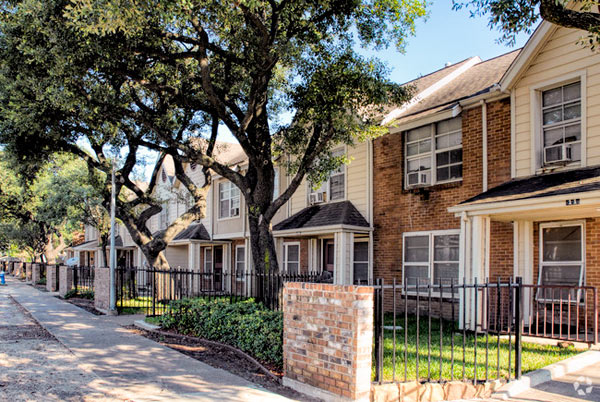 112 of the 296 apartments at Clayton Homes have been deemed “uninhabitable” by its owner, the Houston Housing Authority, which is now seeking to demolish them. The affordable-housing complex tucked between Hwy. 59 and Buffalo Bayou north of Runnels St. in the northwest corner of the East End was flooded after Hurricane Harvey; subsequent investigations conducted by local researchers led by the New York Times and by the authority found numerous health and safety problems in the residences, including festering mold and high levels of E. coli. Submitting a demolition request for those units allowed the authority to receive and distribute “tenant protection vouchers” that will allow their residents to relocate to any voucher-accepting unit in the city, a spokesperson for the agency says: “Since Hurricane Harvey caused extensive damage to many of HHA’s public housing properties, housing options within HHA’s public housing program are now exhausted, which is why residents are receiving vouchers.” The agency says it is also helping Clayton Homes residents not eligible for the vouchers as well to find new homes — with relocation assistance services and one-time payments — and that it is refunding rents collected for periods when homes in the complex were uninhabitable. Photo: Apartments.com
112 of the 296 apartments at Clayton Homes have been deemed “uninhabitable” by its owner, the Houston Housing Authority, which is now seeking to demolish them. The affordable-housing complex tucked between Hwy. 59 and Buffalo Bayou north of Runnels St. in the northwest corner of the East End was flooded after Hurricane Harvey; subsequent investigations conducted by local researchers led by the New York Times and by the authority found numerous health and safety problems in the residences, including festering mold and high levels of E. coli. Submitting a demolition request for those units allowed the authority to receive and distribute “tenant protection vouchers” that will allow their residents to relocate to any voucher-accepting unit in the city, a spokesperson for the agency says: “Since Hurricane Harvey caused extensive damage to many of HHA’s public housing properties, housing options within HHA’s public housing program are now exhausted, which is why residents are receiving vouchers.” The agency says it is also helping Clayton Homes residents not eligible for the vouchers as well to find new homes — with relocation assistance services and one-time payments — and that it is refunding rents collected for periods when homes in the complex were uninhabitable. Photo: Apartments.com
COMMENT OF THE DAY: THE LAST MESSAGE OF DOWNTOWN’S ENTOMBED WESTERN UNION BUILDING  “. . . Soon after I moved to Houston, I had money wired to me at this Western Union building (this would have been November of ’81). Didn’t make much of an impression on me. I think the façade had been stripped off, and the office itself was shabby.
I started work at HL&P in February of ’82, and our offices looked directly across the street to the construction site. The ‘big pour’ for the concrete foundation slab was quite an event. Starting very early on a Sunday morning, a seemingly endless parade of mixer trucks crept down Louisiana Street. Obviously, most of the block had been excavated, and the lot where Western Union sat (well, sits) was supported by a series of diagonal beams. After seeing the engineering required to save that lot, the lower ‘banking hall’ design for that side of the building makes sense.
While construction continued, the south side of the WU was given a fresh coat of paint with a large graphic proclaiming ‘A Gerald R. Hines Project‘ (or some such thing), which doubtlessly is still there, virtually unseen for 35 years.” [BigTex, commenting on Comment of the Day: Inside the Western Union Building Buried Inside the Bank of America Center Downtown] Photo of banking hall interior, looking toward the Western Union building’s south wall: Bank of America Center
“. . . Soon after I moved to Houston, I had money wired to me at this Western Union building (this would have been November of ’81). Didn’t make much of an impression on me. I think the façade had been stripped off, and the office itself was shabby.
I started work at HL&P in February of ’82, and our offices looked directly across the street to the construction site. The ‘big pour’ for the concrete foundation slab was quite an event. Starting very early on a Sunday morning, a seemingly endless parade of mixer trucks crept down Louisiana Street. Obviously, most of the block had been excavated, and the lot where Western Union sat (well, sits) was supported by a series of diagonal beams. After seeing the engineering required to save that lot, the lower ‘banking hall’ design for that side of the building makes sense.
While construction continued, the south side of the WU was given a fresh coat of paint with a large graphic proclaiming ‘A Gerald R. Hines Project‘ (or some such thing), which doubtlessly is still there, virtually unseen for 35 years.” [BigTex, commenting on Comment of the Day: Inside the Western Union Building Buried Inside the Bank of America Center Downtown] Photo of banking hall interior, looking toward the Western Union building’s south wall: Bank of America Center
ALL THE DAMS AND MAGIC WETLANDS CAN DO  Big, fat, cleared floodplains are the best way to handle a very large storm, explains wetlands scientist John Jacob — because nothing else is going to: “An average rainfall of 35 inches over all of Harris County (Harvey) is just over 1 trillion gallons. At most, there are about 50 billion gallons of stormwater detention capacity in Harris County wetlands (no one has measured this — I had to make some very broad assumptions). So that means that the wetlands at best could handle about 5% of the total volume of Harvey rainfall. In the large scheme of things, it’s not much. And the scheme of things in Harvey is indeed very large.
So much for the magic wetlands. But what about our engineered drainage system? I calculate a somewhat larger detention capacity — between our large US Army Corps of Engineers Katy Prairie reservoirs (~400,000 acre-ft) and Harris County Flood Control District detention (about 34,000 acre-feet), we have about 130 billion gallons of detention volume. More than what we have for wetlands, but still only about 14% of Harvey. As we painfully saw, also overwhelmed.
And what of green stormwater infrastructure — rain gardens, bioswales, green roofs, etc.? We don’t have any good numbers here, but you can be sure that even if these practices were widespread, the volume would be very small relative to wetlands and detention basins. These practices are designed to capture at best a 2 inch storm.” [Watershed Texas] Photo of Willow Waterhole Greenspace: Luz (license)
Big, fat, cleared floodplains are the best way to handle a very large storm, explains wetlands scientist John Jacob — because nothing else is going to: “An average rainfall of 35 inches over all of Harris County (Harvey) is just over 1 trillion gallons. At most, there are about 50 billion gallons of stormwater detention capacity in Harris County wetlands (no one has measured this — I had to make some very broad assumptions). So that means that the wetlands at best could handle about 5% of the total volume of Harvey rainfall. In the large scheme of things, it’s not much. And the scheme of things in Harvey is indeed very large.
So much for the magic wetlands. But what about our engineered drainage system? I calculate a somewhat larger detention capacity — between our large US Army Corps of Engineers Katy Prairie reservoirs (~400,000 acre-ft) and Harris County Flood Control District detention (about 34,000 acre-feet), we have about 130 billion gallons of detention volume. More than what we have for wetlands, but still only about 14% of Harvey. As we painfully saw, also overwhelmed.
And what of green stormwater infrastructure — rain gardens, bioswales, green roofs, etc.? We don’t have any good numbers here, but you can be sure that even if these practices were widespread, the volume would be very small relative to wetlands and detention basins. These practices are designed to capture at best a 2 inch storm.” [Watershed Texas] Photo of Willow Waterhole Greenspace: Luz (license)
2100 MEMORIAL RESIDENTS PROTEST BY PAYING THEIR RENT, STAYING HOME 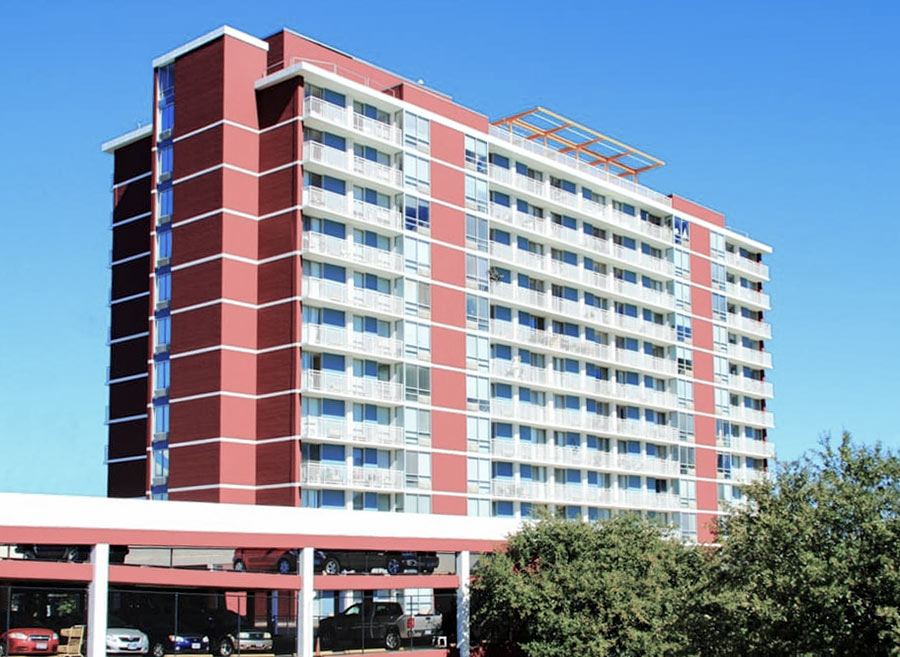 Singing “We shall not be moved,” a group of residents remaining at the 2100 Memorial senior-living apartments just west of Downtown marched into the 14-story building’s leasing office one by one today to deliver their rent checks, Florian Martin reports. A notice delivered 15 days ago to residents of the tax-credit facility owned by the Houston Housing Authority gave them 5 days to move out of the building, but a spokesperson later told Swamplot that the authority would not enforce that deadline. In the meantime, a lawsuit filed just before the move-out date seeking to force the authority both to make repairs to the electrical system and to allow residents to remain in their homes has been revised and expanded to 17 named resident plaintiffs. Flooding compromised the former Holiday Inn building’s fire-safety and electrical systems; the Housing Authority says it is working with residents to find them new places to live. [Houston Public Media; previously on Swamplot] Photo: 2100 Memorial
Singing “We shall not be moved,” a group of residents remaining at the 2100 Memorial senior-living apartments just west of Downtown marched into the 14-story building’s leasing office one by one today to deliver their rent checks, Florian Martin reports. A notice delivered 15 days ago to residents of the tax-credit facility owned by the Houston Housing Authority gave them 5 days to move out of the building, but a spokesperson later told Swamplot that the authority would not enforce that deadline. In the meantime, a lawsuit filed just before the move-out date seeking to force the authority both to make repairs to the electrical system and to allow residents to remain in their homes has been revised and expanded to 17 named resident plaintiffs. Flooding compromised the former Holiday Inn building’s fire-safety and electrical systems; the Housing Authority says it is working with residents to find them new places to live. [Houston Public Media; previously on Swamplot] Photo: 2100 Memorial
ALLEY THEATRE FLOODING DRAMA CAME FROM AN ALLEY THIS TIME, NOT THE TUNNEL 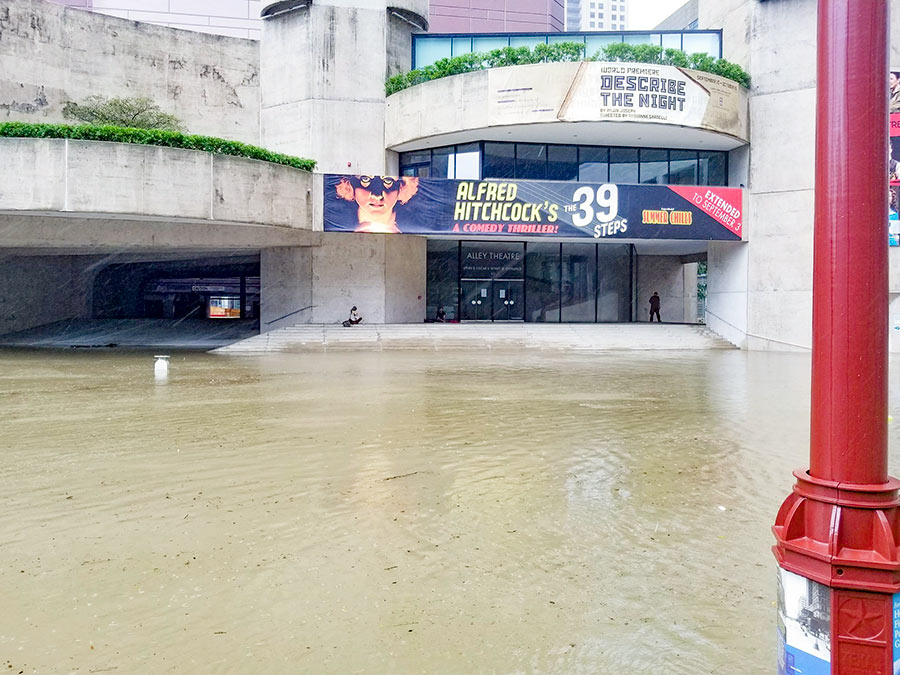 Harvey flooding caused an estimated $15 million of damage to the Alley Theatre’s basement-level stage, lobby, and dressing rooms, but for the most part spared its recently renovated box-office entrance, main stage, and upper-level lobbies. The good news, relayed by theater managing director Dean Gladden in an email to members: Submarine doors in the tunnel prevented water flowing from the Theater District’s underground parking garage from entering the theater as it had during Tropical Storm Allison. But this time there was another way in: a fresh-air intake vent in the Alley’s drive-thru Alleyway driveway fronting Jones Plaza on Texas Ave. (pictured at left in the above photo): “Harvey’s waters crested so high that this in-take vent provided an opening that enabled the flood waters to enter the building unimpeded. The water was so powerful it knocked through a cement block wall and blew open locked doors. When the cement block wall collapsed, it broke a 2-foot fire line that started spewing water out at 150 gallons a minute. About 900,000 gallons of water would come from this source before it was turned off. The flood water from the bayou would account for 2.8 million gallons of water. The water would reach 10-feet high in the Neuhaus Theatre and lobby and 15-feet high in the basement level. The Alley Theatre below ground was completely flooded.” [Alley Theatre] Photo: Jason Hrncir
Harvey flooding caused an estimated $15 million of damage to the Alley Theatre’s basement-level stage, lobby, and dressing rooms, but for the most part spared its recently renovated box-office entrance, main stage, and upper-level lobbies. The good news, relayed by theater managing director Dean Gladden in an email to members: Submarine doors in the tunnel prevented water flowing from the Theater District’s underground parking garage from entering the theater as it had during Tropical Storm Allison. But this time there was another way in: a fresh-air intake vent in the Alley’s drive-thru Alleyway driveway fronting Jones Plaza on Texas Ave. (pictured at left in the above photo): “Harvey’s waters crested so high that this in-take vent provided an opening that enabled the flood waters to enter the building unimpeded. The water was so powerful it knocked through a cement block wall and blew open locked doors. When the cement block wall collapsed, it broke a 2-foot fire line that started spewing water out at 150 gallons a minute. About 900,000 gallons of water would come from this source before it was turned off. The flood water from the bayou would account for 2.8 million gallons of water. The water would reach 10-feet high in the Neuhaus Theatre and lobby and 15-feet high in the basement level. The Alley Theatre below ground was completely flooded.” [Alley Theatre] Photo: Jason Hrncir
LIFE IN ARBOR OAKS, AFTER MOST OF THE NEIGHBORS HAVE MOVED AWAY 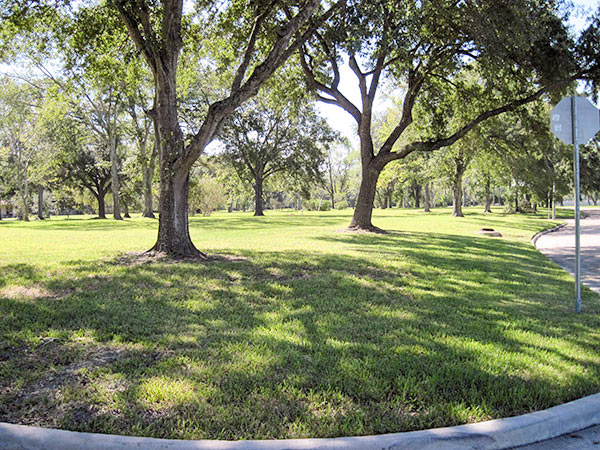 “It’s almost like living in the country,“HOA president and longtime Arbor Oaks resident Gwen Boucher tells Mike Morris. Her home has flooded 9 times in 42 years. A total of 207 properties in her neighborhood, near the intersection of Antoine and W. Little York, have been bought out and torn down since Tropical Storm Allison 16 years ago, at a cost of $36 million. Arbor Oaks is now down to just 13 homes, all of which flooded after Hurricane Harvey. “Though much of the neighborhood has returned to nature, it can feel unnatural. Yellow street signs and speed bumps caution cars that never come. Deep-green hostas still circle clumps of oak trees on vacant Gum Grove, exactly as their long-gone gardeners intended,” Morris writes. “Though some holdouts live within their original fences, others take a less literal approach. Two families have turned adjacent lots into volleyball courts. A handful of the houses sport basketball hoops, which is common enough, except that they are planted, in cement, on vacant lots across the street. Eugene Cox parks spare vehicles on the nearby grass, and is keeping two antique chassis on the street for a friend. Another neighbor, a truck driver, parks his cab on the street.” [Houston Chronicle ($)] Photo of park carved from former Arbor Oaks homesites: Near Northwest Management District
“It’s almost like living in the country,“HOA president and longtime Arbor Oaks resident Gwen Boucher tells Mike Morris. Her home has flooded 9 times in 42 years. A total of 207 properties in her neighborhood, near the intersection of Antoine and W. Little York, have been bought out and torn down since Tropical Storm Allison 16 years ago, at a cost of $36 million. Arbor Oaks is now down to just 13 homes, all of which flooded after Hurricane Harvey. “Though much of the neighborhood has returned to nature, it can feel unnatural. Yellow street signs and speed bumps caution cars that never come. Deep-green hostas still circle clumps of oak trees on vacant Gum Grove, exactly as their long-gone gardeners intended,” Morris writes. “Though some holdouts live within their original fences, others take a less literal approach. Two families have turned adjacent lots into volleyball courts. A handful of the houses sport basketball hoops, which is common enough, except that they are planted, in cement, on vacant lots across the street. Eugene Cox parks spare vehicles on the nearby grass, and is keeping two antique chassis on the street for a friend. Another neighbor, a truck driver, parks his cab on the street.” [Houston Chronicle ($)] Photo of park carved from former Arbor Oaks homesites: Near Northwest Management District
THAT THING ABOUT THE CITY OF HOUSTON AND DIGITAL BILLBOARDS 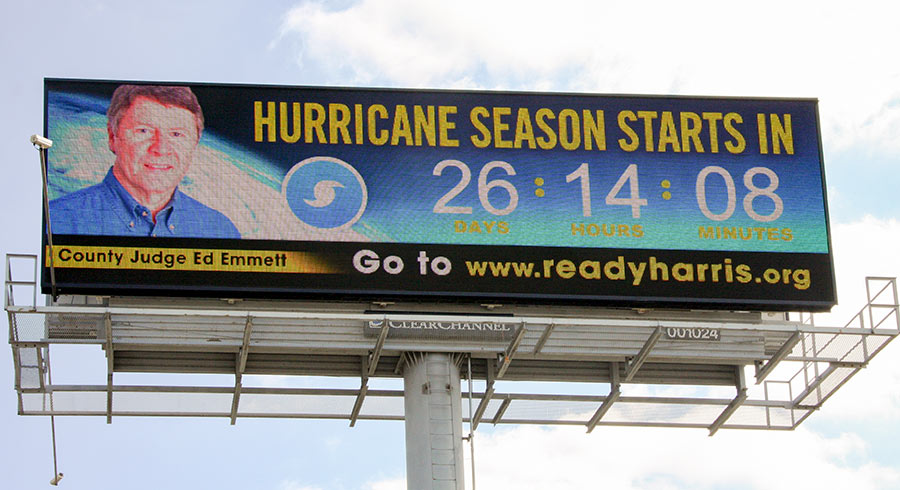 A reader with “nothing better to do today” writes in with a question for Swamplot readers: “I do not see any digital billboards in Houston city limits. I see them popping up in Baytown and I’m sure elsewhere, but why not H-Town? One would think that this would be a win-win for the owners of the billboards and the businesses wanting to advertise their product. I see them all over Dallas — Houston, not so much.” Photo: Houston Public Media
A reader with “nothing better to do today” writes in with a question for Swamplot readers: “I do not see any digital billboards in Houston city limits. I see them popping up in Baytown and I’m sure elsewhere, but why not H-Town? One would think that this would be a win-win for the owners of the billboards and the businesses wanting to advertise their product. I see them all over Dallas — Houston, not so much.” Photo: Houston Public Media
COMMENT OF THE DAY: YOU SHOULD GET FLOOD INSURANCE EVEN IF YOU LIVE OUTSIDE ANY DESIGNATED FLOODPLAIN  “Consider the following:
1.) Houston as a whole is a low-lying area.
2.) FEMA Flood Maps are outdated; this is not a new revelation following Harvey.
3.) Flood insurance for Zone X is cheap (I pay $425/year for $200k building/$80k contents coverage)
4.) Your house is outside of both the 1% and 0.2% flood plains (i.e. Zone X).
Given those four conditions alone, buying flood insurance should be a no brainer for anyone that owns property in Houston, particularly if you’re even *near* a 100- or 500-year line. And after this event, which has made it quite clear that the models that determine what a 0.2% and 1% event is are inadequate, not getting flood insurance wherever you are in this town makes no sense at all. Heck, it doesn’t even take a Harvey to flood your ‘never been flooded house’ – all it takes is a blocked storm drain, a collapsed drainage ditch, poor lot grading, or any number of other non-“biblical†localized catastrophic events. Hopefully more people will realize this now, but it’s very sad that so many didn’t until 40-50 in. of rain fell over the entire county in less than 48 hours. [meh, commenting on Suing the Army Corps for Reservoir Releases; A City App for Debris Removal; 30 Years of the GRB] Illustration: Lulu
“Consider the following:
1.) Houston as a whole is a low-lying area.
2.) FEMA Flood Maps are outdated; this is not a new revelation following Harvey.
3.) Flood insurance for Zone X is cheap (I pay $425/year for $200k building/$80k contents coverage)
4.) Your house is outside of both the 1% and 0.2% flood plains (i.e. Zone X).
Given those four conditions alone, buying flood insurance should be a no brainer for anyone that owns property in Houston, particularly if you’re even *near* a 100- or 500-year line. And after this event, which has made it quite clear that the models that determine what a 0.2% and 1% event is are inadequate, not getting flood insurance wherever you are in this town makes no sense at all. Heck, it doesn’t even take a Harvey to flood your ‘never been flooded house’ – all it takes is a blocked storm drain, a collapsed drainage ditch, poor lot grading, or any number of other non-“biblical†localized catastrophic events. Hopefully more people will realize this now, but it’s very sad that so many didn’t until 40-50 in. of rain fell over the entire county in less than 48 hours. [meh, commenting on Suing the Army Corps for Reservoir Releases; A City App for Debris Removal; 30 Years of the GRB] Illustration: Lulu

